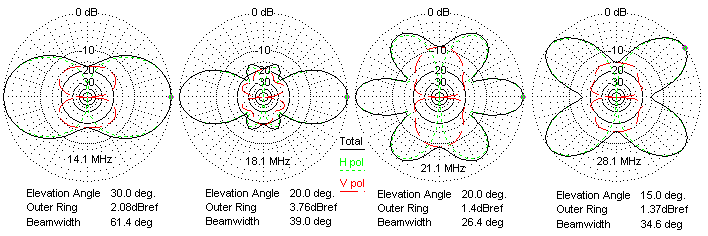

|
Spring 2001 should bring the best opportunity for working Australia and New Zealand stations we have had in a long time. My current Super Zep wire beam will attenuate the signals coming from that part of the world on 20 meters, and so a new solution is needed. Removing the reflector would solve the problem, but I can do even better than that... To relieve my winter cabin fever, I modeled another wire to construct as soon as warmer drier days arrive. I used the same model as the NB6Zep antenna and reduced the horizontal portion to 55 feet in order to fit in the space of my Super Zep. This will remove the extended phasing of the double zepp on 20 meters, but adds it on 17 meters. It becomes a true half wave dipole on 40 meters and 2 waves long on 10 meters. It looked good on the computer, so down came the Super Zep and up goes the NB6Zep Jr.
Basic Construction:
The same construction materials and techniques described for the NB6Zep antenna are used for the junior version. The balanced transmission line length can be changed to meet your needs, and a step down balun device can be used if coax must be used at the end of the balanced line to bring the line into the tuner. Use a tuner that is properly rated for the levels you will operate at. If your tuner has trouble matching on a particular band due to a high line impedances, try changing the transmission line length. If needed, only use high quality coax in the transmission line and keep power levels reasonable at all times to avoid damaging the coax.
Basic Performance: Unlike the NB6Zep antenna, the NB6Zep Jr must be considerred a tuned antenna, and will have some interaction with other horizontal antennas in the yard. You should remove any dipoles for best results... My first 6 contacts were with European stations on 15 and 20 meters using 50 watts on MFSK16, PSK31 and RTTY modes. I am expecting equal performance off of the back side of the antenna when band conditions permit.  The same 80 meter modification described for the NB6Zep will work for this shorter version.
|